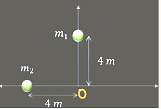A 10 μC charge is divided into two equal parts and kept at 1 cm distance. Find repulsion between charges?
- 225 N
- 450 N
- 2250 N
- 4500 N
The Correct Option is C
Solution and Explanation
The correct option is (C): 2250 N
\(F=\frac{9\times10^9\times(5\times10^{-6})^2}{(10^{-2})^2}\space\)
\(= 9\times25\times10=2250N\)
Top Questions on Electric charges and fields
- Two particles each of mass \(2\) kg are places as shown in \(x→ y\) plane. If the distance of centre of mass from origin is \(\frac{4\sqrt 2}{x}\) find \(x\) :

- JEE Main - 2024
- Physics
- Electric charges and fields
- A uniform electric field of $10 N / C$ is created between two parallel charged plates (as shown in figure) An electron enters the field symmetrically between the plates with a kinetic energy $05 eV$ The length of each plate is $10 cm$ The angle $(\theta)$ of deviation of the path of electron as it comes out of the field is ___ (in degree)

- JEE Main - 2023
- Physics
- Electric charges and fields
- Electric field in a certain region is given by $\overrightarrow{ E }=\left(\frac{ A }{x^2} \hat{i}+\frac{ B }{y^3} \hat{j}\right)$ The $SI$ unit of $A$ and $B$ are :
- JEE Main - 2023
- Physics
- Electric charges and fields
Given below are two statements : One is labelled as Assertion $A$ and the other is labelled as Reason R
Assertion A : Two metallic spheres are charged to the same potential One of them is hollow and another is solid, and both have the same radii Solid sphere will have lower charge than the hollow one
Reason R : Capacitance of metallic spheres depend on the radii of spheres
In the light of the above statements, choose the correct answer from the options given belows- JEE Main - 2023
- Physics
- Electric charges and fields
- A condenser of $2 \,\mu F$ capacitance is charged steadily from $0$ to $5 C$ Which of the following graph represents correctly the variation of potential difference $(V)$ across it's plates with respect to the charge $( Q )$ on the condenser?
- JEE Main - 2023
- Physics
- Electric charges and fields
Questions Asked in JEE Main exam
- Let \[\vec{a} = \hat{i} + \hat{j} + \hat{k}, \quad \vec{b} = -\hat{i} - 8\hat{j} + 2\hat{k}, \quad \text{and} \quad \vec{c} = 4\hat{i} + c_2\hat{j} + c_3\hat{k} \]be three vectors such that \[\vec{b} \times \vec{a} = \vec{c} \times \vec{a}.\]If the angle between the vector $\vec{c}$ and the vector $3\hat{i} + 4\hat{j} + \hat{k}$ is $\theta$, then the greatest integer less than or equal to $\tan^2 \theta$ is:
- JEE Main - 2024
- Vector Algebra
- 10 mL of gaseous hydrocarbon on combustion gives 40 mL of CO\(_2\)(g) and 50 mL of water vapour. The total number of carbon and hydrogen atoms in the hydrocarbon is ______ .
- JEE Main - 2024
- Hydrocarbons
- If each term of a geometric progression \( a_1, a_2, a_3, \dots \) with \( a_1 = \frac{1}{8} \) and \( a_2 \neq a_1 \), is the arithmetic mean of the next two terms and \( S_n = a_1 + a_2 + \dots + a_n \), then \( S_{20} - S_{18} \) is equal to
- JEE Main - 2024
- Arithmetic Mean
A body of mass 1000 kg is moving horizontally with a velocity of 6 m/s. If 200 kg extra mass is added, the final velocity (in m/s) is:
- JEE Main - 2024
- speed and velocity
- $\textbf{Choose the correct statements about the hydrides of group 15 elements.}$
A. The stability of the hydrides decreases in the order \(\text{NH}_3 > \text{PH}_3 > \text{AsH}_3 > \text{SbH}_3 > \text{BiH}_3\)
B. The reducing ability of the hydrides increases in the order \(\text{NH}_3 < \text{PH}_3 < \text{AsH}_3 < \text{SbH}_3 < \text{BiH}_3\)
C. Among the hydrides, \(\text{NH}_3\) is a strong reducing agent while \(\text{BiH}_3\) is a mild reducing agent.
D. The basicity of the hydrides increases in the order \(\text{NH}_3 < \text{PH}_3 < \text{AsH}_3 < \text{SbH}_3 < \text{BiH}_3\)
Choose the most appropriate from the option given below:- JEE Main - 2024
- p -Block Elements
Concepts Used:
Coulomb’s Law
In 1785, french physicist Charles Augustin de Coulomb coined a tangible relationship in mathematical form between two bodies that have been electrically charged. He represented an equation for the force causing the bodies to attract or repel each other which is commonly known as Coulomb’s law or Coulomb’s inverse-square law.
As per Coulomb’s law, the force of attraction or repulsion between two charged bodies is directly proportional to the product of their charges and inversely proportional to the square of the distance between them. It acts along the line joining the two charges regarded to be point charges.
Coulomb’s Law has an abundant application to modern life, from Xerox machines to laser printers, to powder coating.



